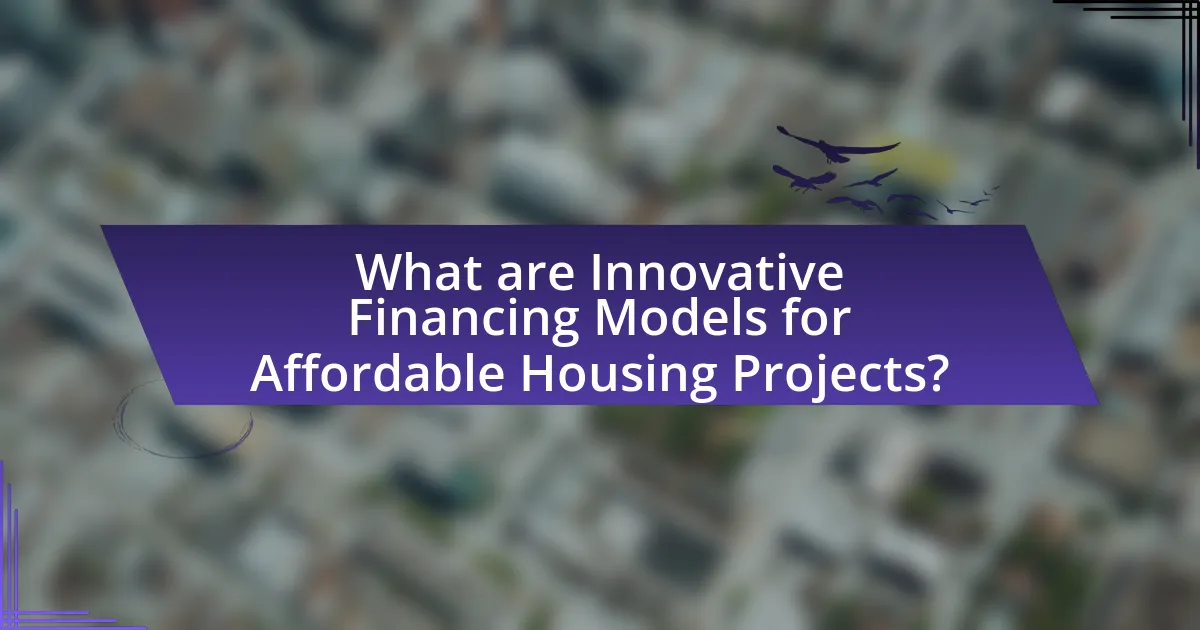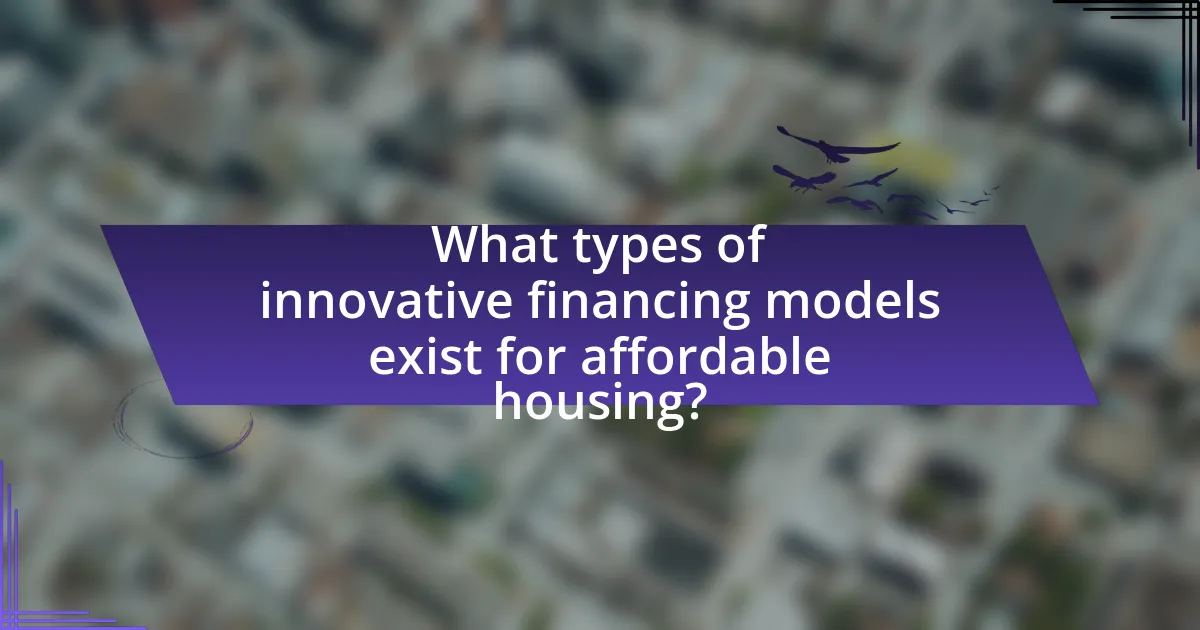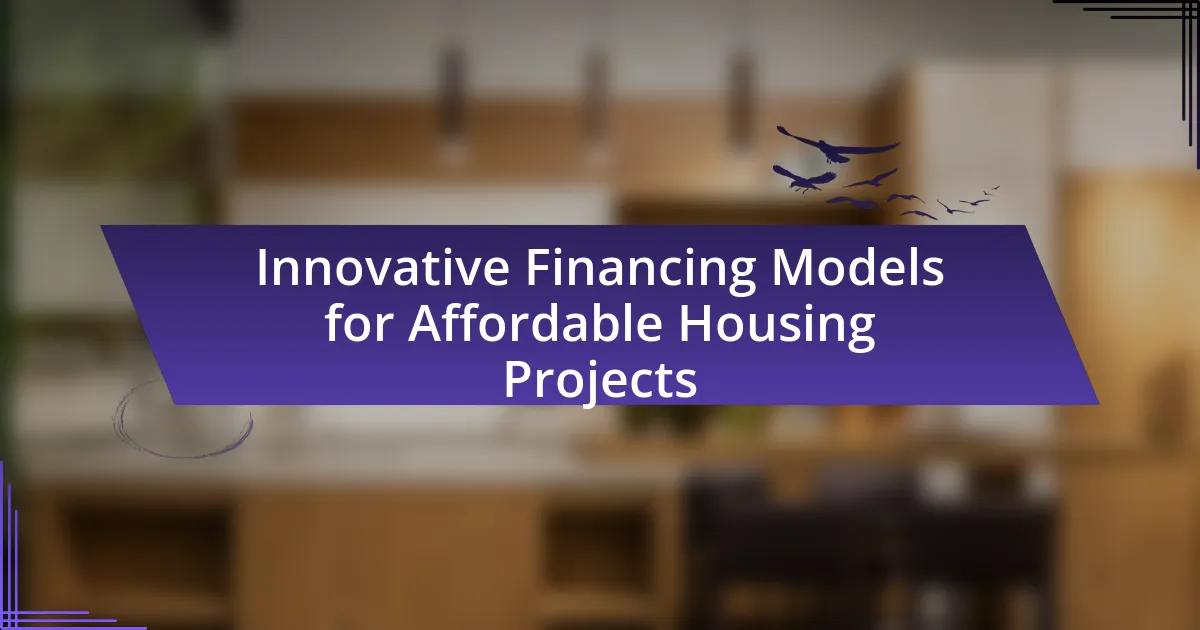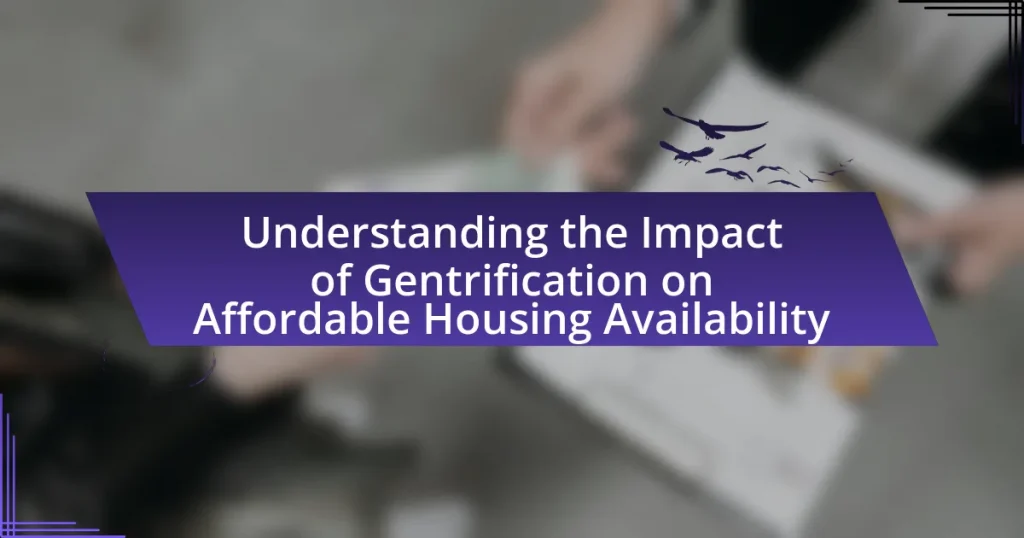Innovative financing models for affordable housing projects encompass mechanisms such as social impact bonds, community land trusts, and public-private partnerships. These models differ from traditional financing methods by utilizing diverse funding sources and promoting collaboration among stakeholders, which enhances project sustainability and accelerates capital mobilization. Key characteristics include flexibility, risk-sharing, and the ability to address funding gaps, ultimately improving housing accessibility and contributing to sustainable urban development. The article further explores the functioning of these models, their benefits and challenges, and best practices for effective implementation, providing a comprehensive overview of their impact on affordable housing initiatives.

What are Innovative Financing Models for Affordable Housing Projects?
Innovative financing models for affordable housing projects include mechanisms such as social impact bonds, community land trusts, and public-private partnerships. Social impact bonds allow private investors to fund housing initiatives, with returns based on the achievement of specific social outcomes, thus reducing the financial burden on public resources. Community land trusts enable communities to collectively own land, ensuring long-term affordability by separating land ownership from housing development. Public-private partnerships leverage both public and private sector resources to finance and develop affordable housing, often resulting in shared risks and benefits. These models have been shown to effectively address funding gaps and enhance the sustainability of affordable housing initiatives.
How do these financing models differ from traditional methods?
Innovative financing models differ from traditional methods primarily in their approach to funding and risk-sharing. Traditional financing often relies on bank loans and government subsidies, which can be limited and slow to access. In contrast, innovative models utilize diverse sources such as crowdfunding, social impact bonds, and public-private partnerships, enabling quicker capital mobilization and broader participation. For instance, crowdfunding platforms have raised millions for affordable housing projects, demonstrating a shift towards community-driven funding mechanisms that enhance engagement and investment from local stakeholders. This diversification not only accelerates project timelines but also spreads financial risk among multiple parties, making it more resilient to economic fluctuations.
What are the key characteristics of innovative financing models?
Innovative financing models are characterized by flexibility, collaboration, and risk-sharing. These models adapt to the unique needs of affordable housing projects by incorporating diverse funding sources, such as public-private partnerships, social impact bonds, and community investment funds. For instance, the use of social impact bonds allows private investors to fund social programs with the potential for returns based on the achievement of specific outcomes, thus aligning financial incentives with social goals. Additionally, innovative financing models often leverage technology to streamline processes and enhance transparency, making it easier for stakeholders to engage and invest. This approach not only mobilizes capital but also fosters a collaborative environment among various stakeholders, including government entities, non-profits, and private investors, ultimately driving the success of affordable housing initiatives.
How do these models address the challenges of affordable housing?
Innovative financing models address the challenges of affordable housing by providing alternative funding mechanisms that reduce reliance on traditional financing sources. These models, such as social impact bonds and community land trusts, enable the pooling of resources from various stakeholders, including private investors and public entities, to create sustainable housing solutions. For instance, social impact bonds link financial returns to measurable social outcomes, incentivizing investors to support affordable housing initiatives that demonstrate success in reducing homelessness or improving living conditions. Additionally, community land trusts allow communities to collectively own land, ensuring long-term affordability and stability in housing prices. These approaches have been shown to effectively mobilize capital and foster collaboration, ultimately leading to increased availability of affordable housing options.
Why are innovative financing models important for affordable housing?
Innovative financing models are important for affordable housing because they provide flexible funding solutions that can adapt to diverse community needs and economic conditions. These models, such as social impact bonds and public-private partnerships, enable the mobilization of private capital to supplement traditional funding sources, addressing the significant funding gap in affordable housing. For instance, according to the National Low Income Housing Coalition, there is a shortage of 7 million affordable rental homes for extremely low-income renters in the United States, highlighting the urgent need for alternative financing strategies to meet housing demands.
What impact do these models have on housing accessibility?
Innovative financing models significantly enhance housing accessibility by providing alternative funding sources that reduce reliance on traditional financing methods. These models, such as social impact bonds and community land trusts, enable developers to create affordable housing units more efficiently. For instance, a study by the Urban Institute found that projects utilizing innovative financing can increase the number of affordable units by up to 30% compared to conventional methods. This increase in affordable housing availability directly addresses the growing demand for accessible housing options in urban areas, thereby improving overall housing accessibility for low- and moderate-income families.
How do they contribute to sustainable urban development?
Innovative financing models for affordable housing projects contribute to sustainable urban development by enabling the construction and maintenance of environmentally friendly and economically viable housing. These models, such as public-private partnerships and social impact bonds, facilitate investment in affordable housing, which reduces urban sprawl and promotes efficient land use. For instance, a study by the Urban Institute found that leveraging private capital through innovative financing can increase the availability of affordable housing units, thereby supporting community stability and reducing homelessness. This approach not only addresses housing shortages but also fosters sustainable practices, such as energy-efficient building designs, which contribute to lower carbon footprints in urban areas.

What types of innovative financing models exist for affordable housing?
Innovative financing models for affordable housing include community land trusts, social impact bonds, and public-private partnerships. Community land trusts allow communities to collectively own land, reducing costs for housing development while ensuring long-term affordability. Social impact bonds involve private investors funding social programs with returns based on the achievement of specific outcomes, such as reduced homelessness. Public-private partnerships leverage both public resources and private investment to develop affordable housing, often resulting in shared risks and benefits. These models have been shown to effectively address funding gaps and enhance the sustainability of affordable housing initiatives.
How do public-private partnerships function in this context?
Public-private partnerships (PPPs) in the context of innovative financing models for affordable housing projects function by combining resources, expertise, and risk-sharing between government entities and private sector companies. These collaborations enable the development of affordable housing by leveraging private investment to complement public funding, thus increasing the overall financial capacity for such projects. For example, in the United States, the Low-Income Housing Tax Credit program incentivizes private developers to invest in affordable housing, demonstrating how PPPs can effectively mobilize private capital while ensuring public interest is served.
What are the benefits of public-private partnerships for affordable housing?
Public-private partnerships (PPPs) for affordable housing provide several key benefits, including increased funding, risk sharing, and enhanced efficiency in project delivery. These partnerships leverage public resources and private sector expertise, resulting in a more effective allocation of capital. For instance, a study by the Urban Institute found that PPPs can reduce project costs by up to 20% through streamlined processes and innovative construction techniques. Additionally, PPPs facilitate access to diverse financing sources, enabling the development of more affordable units. By combining the strengths of both sectors, these partnerships can accelerate the development timeline and improve the quality of housing projects, ultimately addressing the affordable housing crisis more effectively.
What challenges do these partnerships face?
Partnerships in innovative financing models for affordable housing projects face several challenges, including misalignment of goals, regulatory hurdles, and funding constraints. Misalignment of goals occurs when stakeholders have differing priorities, which can lead to conflicts and inefficiencies. Regulatory hurdles often arise from complex zoning laws and compliance requirements that can delay project timelines. Funding constraints are prevalent as securing adequate financial resources can be difficult, especially in economically challenging environments. According to a report by the Urban Institute, 70% of affordable housing projects encounter significant delays due to these regulatory and funding issues, highlighting the critical nature of these challenges in successful partnerships.
What role do social impact bonds play in affordable housing financing?
Social impact bonds (SIBs) serve as a financing mechanism that links private investment to social outcomes in affordable housing projects. By attracting private capital, SIBs enable funding for initiatives aimed at improving housing stability and reducing homelessness, with returns contingent on achieving specified social outcomes. For instance, a study by the Urban Institute highlights that SIBs can mobilize resources for preventive measures in housing, thereby reducing long-term costs for public services. This model incentivizes collaboration among stakeholders, including government entities, non-profits, and investors, to address housing challenges effectively.
How do social impact bonds work?
Social impact bonds (SIBs) work by creating a financial instrument that funds social programs through private investment, with returns contingent on the achievement of specific social outcomes. In this model, private investors provide upfront capital to fund social services, such as affordable housing initiatives, while the government or other entities agree to pay back the investors with interest if the program meets predetermined success metrics, such as reduced homelessness rates or improved housing stability. This approach aligns financial incentives with social outcomes, encouraging efficiency and effectiveness in service delivery. The first SIB was launched in the UK in 2010, demonstrating the potential for this model to attract private capital to address social issues while minimizing public risk.
What are the potential outcomes of using social impact bonds?
The potential outcomes of using social impact bonds include improved social services, enhanced funding for preventive programs, and measurable social outcomes. Social impact bonds facilitate investment in initiatives aimed at addressing social issues, such as homelessness or education, by linking financial returns to the achievement of specific social outcomes. For instance, a study by the UK’s Ministry of Justice reported that the Peterborough Social Impact Bond led to a 9% reduction in reoffending rates among short-sentenced prisoners, demonstrating the effectiveness of this financing model in achieving tangible social benefits.

How can stakeholders implement innovative financing models effectively?
Stakeholders can implement innovative financing models effectively by fostering collaboration among public, private, and nonprofit sectors to leverage diverse funding sources. This collaborative approach enables stakeholders to pool resources, share risks, and access capital markets, which is essential for financing affordable housing projects. For instance, the use of social impact bonds has been shown to attract private investment for social outcomes, as evidenced by the success of the Peterborough Prison project in the UK, which generated savings for the government while improving rehabilitation rates. By aligning incentives and establishing clear metrics for success, stakeholders can ensure that innovative financing models are not only implemented but also sustained over time.
What strategies can developers use to attract investment?
Developers can attract investment by implementing targeted marketing strategies, building strong partnerships, and demonstrating financial viability. Targeted marketing strategies involve identifying and reaching out to potential investors through tailored presentations that highlight the project’s unique value proposition and community impact. Building strong partnerships with local governments, non-profits, and community organizations can enhance credibility and provide access to additional funding sources. Demonstrating financial viability through detailed financial projections, risk assessments, and showcasing previous successful projects can instill confidence in investors. For instance, a study by the Urban Land Institute indicates that projects with clear financial plans and community support are 30% more likely to secure funding.
How can community engagement enhance financing efforts?
Community engagement can enhance financing efforts by fostering trust and collaboration between stakeholders, which leads to increased investment and support for projects. When communities are actively involved in the planning and decision-making processes, they are more likely to contribute resources, advocate for funding, and attract investors who value community input. For instance, a study by the Urban Institute found that projects with strong community engagement saw a 30% increase in funding compared to those without such involvement. This demonstrates that engaged communities can effectively mobilize financial resources and create a more favorable environment for innovative financing models in affordable housing projects.
What role does government policy play in supporting these models?
Government policy plays a crucial role in supporting innovative financing models for affordable housing projects by providing regulatory frameworks, financial incentives, and funding mechanisms. These policies can include tax credits, grants, and low-interest loans that encourage private investment in affordable housing. For instance, the Low-Income Housing Tax Credit program in the United States has facilitated the development of over 3 million affordable housing units since its inception in 1986, demonstrating the effectiveness of government intervention in promoting housing affordability. Additionally, policies that streamline zoning regulations and reduce bureaucratic hurdles can enhance the feasibility of these financing models, ultimately leading to increased housing supply and improved access for low-income populations.
What best practices should be followed in innovative financing for affordable housing?
Best practices in innovative financing for affordable housing include leveraging public-private partnerships, utilizing social impact bonds, and implementing community land trusts. Public-private partnerships enable shared risk and resource pooling, which can enhance project viability and funding access. Social impact bonds attract private investment by linking returns to measurable social outcomes, thus incentivizing affordable housing development. Community land trusts ensure long-term affordability by separating land ownership from housing, allowing for sustainable development. These practices are supported by successful case studies, such as the New York City Housing Development Corporation’s use of social impact bonds, which has demonstrated effective funding for affordable housing initiatives.
How can risk management be effectively addressed?
Risk management can be effectively addressed by implementing a comprehensive framework that identifies, assesses, and mitigates potential risks throughout the project lifecycle. This involves conducting thorough risk assessments to pinpoint financial, operational, and market risks specific to affordable housing projects. For instance, a study by the Urban Institute highlights that integrating risk management strategies, such as diversifying funding sources and engaging stakeholders early, can significantly reduce project vulnerabilities. Additionally, utilizing data analytics to forecast potential risks allows for proactive measures, ensuring that projects remain on track and within budget.
What metrics should be used to evaluate the success of financing models?
The metrics used to evaluate the success of financing models for affordable housing projects include return on investment (ROI), cost per unit, occupancy rates, and social impact assessments. ROI measures the profitability of the financing model, while cost per unit evaluates the efficiency of resource allocation. Occupancy rates indicate the demand and effectiveness of the housing provided, and social impact assessments gauge the broader benefits to the community, such as improved living conditions and economic mobility. These metrics provide a comprehensive view of both financial performance and social outcomes, essential for determining the overall success of financing models in this sector.
What are the common pitfalls to avoid in innovative financing models?
Common pitfalls to avoid in innovative financing models include lack of stakeholder engagement, inadequate risk assessment, and insufficient understanding of market dynamics. Lack of stakeholder engagement can lead to misalignment of goals and reduced support for projects, as evidenced by studies showing that projects with strong community involvement have higher success rates. Inadequate risk assessment can result in unforeseen financial challenges, as highlighted by the failure of several projects that did not account for economic fluctuations. Lastly, insufficient understanding of market dynamics can lead to unrealistic financial projections, which has been documented in various case studies where projects failed due to overestimation of demand or funding availability.
How can stakeholders mitigate financial risks?
Stakeholders can mitigate financial risks by diversifying funding sources and implementing robust financial management practices. Diversification reduces reliance on a single funding stream, thereby spreading risk across various financial instruments such as grants, loans, and equity investments. For instance, a study by the Urban Institute highlights that affordable housing projects that utilize a mix of public and private funding are more resilient to economic fluctuations. Additionally, stakeholders can adopt financial management strategies like regular risk assessments and contingency planning, which help identify potential financial challenges early and allow for proactive measures. This approach is supported by data from the National Housing Conference, which indicates that projects with comprehensive financial oversight experience fewer budget overruns and financial shortfalls.
What lessons can be learned from past projects?
Lessons learned from past projects in innovative financing models for affordable housing include the importance of stakeholder collaboration, the need for flexible financing structures, and the value of data-driven decision-making. Stakeholder collaboration ensures that the diverse needs of communities are met, as evidenced by the success of projects like the New York City Housing Authority’s mixed-income developments, which involved input from residents and local organizations. Flexible financing structures, such as public-private partnerships, have proven effective in leveraging resources, as seen in the Low-Income Housing Tax Credit program, which has facilitated the creation of over 3 million affordable housing units since its inception. Data-driven decision-making enhances project outcomes by allowing for better assessment of community needs and resource allocation, demonstrated by the use of geographic information systems (GIS) in identifying areas with the greatest housing shortages.



